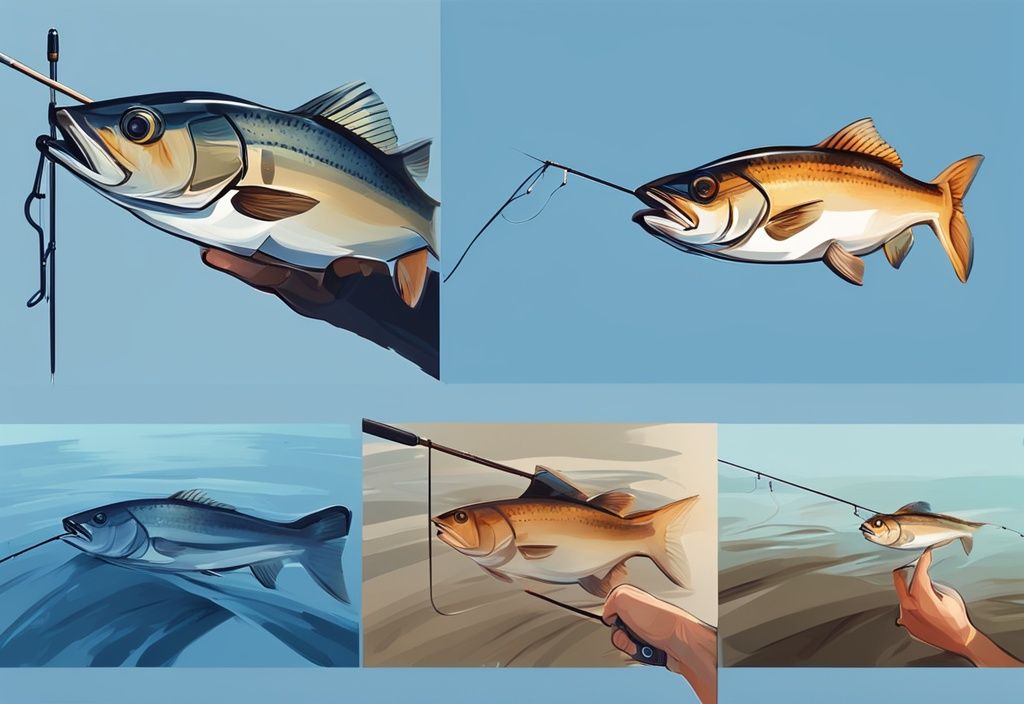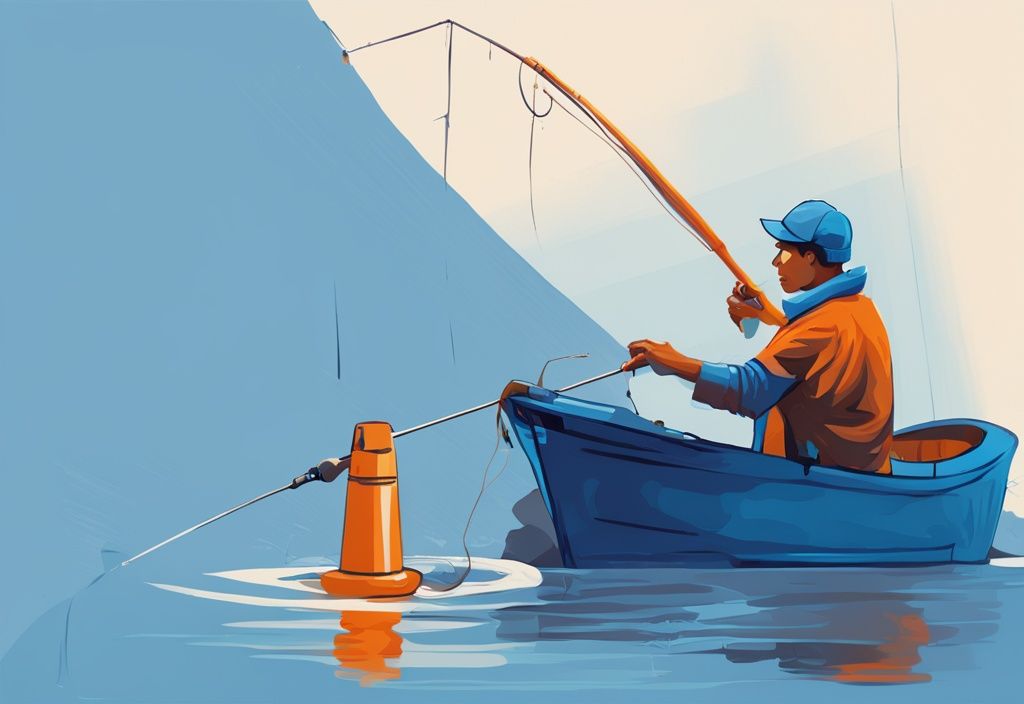Ever tangled with a monster marlin, only to snap your favorite rod in the heat of battle? It’s gut-wrenching, eh? Now, imagine that same heartbreak, except you’ve not even cast a line – your rod arrived damaged from shipping. This ain’t a fish tale, folks. But don’t worry, I’ve got you covered.
Our main catch today is how to ship fishing rods without losing sleep over breakage or damage. I’ll be reeling in details on packing tactics, right down to choosing trusty shipping services to ensure these beauties arrive right as rain, no matter how far they travel.
Get ready to dive in and make your gear shipping process as smooth as a new reel. With my seasoned guidance, you’ll soon enjoy an efficient, stress-free method of sending your delicate items safely across the miles. Let’s get this tackle box talk underway!
Essential Steps for Proper Packaging of Fishing Rods
When it comes to ensuring your fishing rods arrive intact, there are specific steps that every angler should consider. Let’s delve into the details that will keep your gear safe and sound.
The Crucial Role of Proper Packaging
Understanding how to ship fishing rods starts with recognizing the significance of spot-on packaging. Fishing rods are fragile by nature, often made from break-prone materials if they’re not handled with care. Imagine this: you’re reeling in a catch after hours of waiting, and the rod snaps. Heartbreaking, right? That’s why using sturdy packaging materials like bubble wrap or foam is crucial. These materials act as a cushion, limiting movement within the container and dramatically reducing the risk of damage.
Quality packaging not only guards against severe damage like breakage but also shields from minor scratches. For more insights on how to package fragile items effectively, check out this helpful resource on how to package fragile items for shipping. I mean, who wants a scratched-up rod? By reinforcing the packaging, you’re ensuring that your fishing rods stay in pristine condition, both in look and function.
Avoiding Common Shipping Damages
To get the hang of how to ship fishing rods, it’s vital to know the usual culprits of shipping damage: breakage, scratches, and stress from bending. These are often the result of poor packaging techniques. Avoiding these pitfalls starts with a proper wrap-up job. Use bubble wrap or foam to tightly secure the rod, cushioning it against any shocks and keeping it stable inside the package. No movement equals no damage.
Another pro tip? Detach the reel and pack it separately. Trust me, this step is a game-changer. It removes extra stress from the rod and keeps the reel in tip-top shape. Wrap it up individually in bubble wrap or foam, and you’ve got a more stable, secure package overall, drastically cutting down the risk of shipping mishaps.
Picking the Right Container for Your Fishing Rods
Shipping your precious fishing rods doesn’t have to be a headache. Whether you’re mailing them across the country or just a few towns over, choosing the right container can make all the difference. Let’s dive into your top options and ensure your gear arrives safe and sound.
A Look at Heavy-Duty Cardboard Tubes
When it comes to answering the question of how to ship fishing rods, heavy-duty cardboard tubes are a favorite among many anglers. These bright cylinders are not only budget-friendly but also pretty effective for shorter distances. Imagine them like a solid handshake – firm but not overpowering.
Cardboard tubes can handle the usual bumps and jostles, making them a decent pick if you’re not shipping across rocky terrains or vast oceans. However, if you’re eyeing a journey fraught with potential hazards, you might want something sturdier. Think of the difference between a weekend fishing trip at your local pond and a week-long expedition in rough waters. The latter calls for more robust planning.
Why PVC Tubes Could be Your Best Bet
For those precious rods that need to traverse great distances or withstand rough handling, PVC tubes are akin to the fortresses of shipping. Their durability is top-notch, providing peace of mind that your rods will arrive unscathed. Imagine using armor for your fishing gear – that’s what PVC tubes offer.

With their high resistance to crushing forces and waterproof nature, PVC tubes step up the game. A 2″ diameter is generally sufficient, but if you’re packing bulkier rods or additional padding, a 3″ diameter will give you that extra wiggle room. It’s like upgrading from a regular seat to first class – more space and a lot more comfort.
So, when it comes to how to ship fishing rods, you can’t go wrong with PVC. Investing a bit more in these tubes translates to much more protection and fewer worries down the line.
Effective Techniques to Secure Your Fishing Rods
Packing and shipping your precious fishing rods requires the right techniques to ensure they reach their destination safely. Here are some tried-and-true methods to keep your rods in pristine condition during transit.
Use of Bubble Wrap or Foam for Protection
One of the key steps in how to ship fishing rods involves encasing each rod with bubble wrap or foam. Picture this: you’ve just landed a big catch, and the excitement is palpable. Now, channel that care into wrapping your rods. Wrap each rod individually, making sure the cushioning absorbs potential shocks. Bubble wrap or foam acts like a padded cocoon, protecting your gear from the rigors of the journey. Secure it with tape to keep everything in place. Trust me, you’ll sleep better knowing your rods are snug and safe.
How to Detach and Safeguard the Reel
Now, let’s talk reels. If your rod comes with a reel attached, detach it before shipping. This move is critical. Renting stress on the rod and reel is like cutting loose a snagged line—necessary and effective. Just like with the rod, envelop the reel in bubble wrap or foam. Place it snugly in a smaller box or designated compartment within your main container. Picture this like baiting a hook just right; you want everything well-secured to avoid any jostling during transit.
Securing the Package: The Role of Packing Tape
Next up: sealing the deal—or in this case, the package. Use sturdy packing tape to close your container securely. Picture the tape as the final knot in your fishing line—essential for keeping it all together. Reinforce the edges and seams of the box or tube, giving extra attention to weak points. This will ensure the package holds tight, even if it bumps into some rough waters on its journey. A well-taped box is your best ally against accidental openings and rough handling.
The Importance of Labeling Your Package as Fragile
Labeling your package can be a game-changer. Mark it with “Fragile” stickers to make sure everyone knows these rods need special care. Imagine those stickers as your signal flare—alerting all handlers to be cautious. Opt for bright, eye-catching labels so they can’t be missed. This simple step can significantly reduce the chances of mishandling. Think of it as protecting your rods with an extra layer of vigilance.
Choosing the Ideal Shipping Service for Your Fishing Rods
Shipping your prized fishing rods can be a daunting task, especially when you want them to arrive in one piece. Let’s dive into the nitty-gritty details of different shipping services to make sure your gear reaches its destination safely and soundly.
FedEx vs UPS: The Battle for Reliability
When figuring out how to ship fishing rods, reliability is key, and both FedEx and UPS offer strong track records for transporting delicate items. Each service comes with its own set of advantages, so comparing their offerings is essential.
FedEx is known for its timely deliveries and excellent tracking capabilities, making it a top choice for many. They offer a variety of insurance options and handling policies tailored for fragile items, which can give you additional peace of mind.
UPS, on the other hand, is equally reputable, providing reliable shipping with similar tracking and insurance benefits. Reviewing the pricing for each service as well as their specific handling practices for fragile goods will help you decide which carrier aligns best with your needs.
Why USPS May Not be the Best Choice
While considering how to ship fishing rods, it’s important to note that USPS might not be the optimal choice for fragile items. The primary concern lies in their higher instances of mishandling and damage. Although USPS might offer lower costs and wide availability, these benefits are often overshadowed by the potential risks involved.
Unless you have no other alternative, use USPS only if you feel confident in your packaging’s robustness. Even then, thorough precautions such as heavy use of bubble wrap, foam padding, and sturdy containers should be implemented to minimize the risk.
Understanding Shipping Policies for Fragile Items
Grasping the nuances of shipping policies for fragile items is crucial when figuring out how to ship fishing rods effectively. Each carrier has its own set of packaging requirements and procedures for handling delicate shipments. Make sure to review these guidelines thoroughly.
Carriers generally provide detailed instructions on the kind of packaging materials to use, how to wrap items securely, and the necessary labeling to ensure safe transit. Additionally, choosing a service that offers comprehensive insurance can shield you from financial losses in case of damage.
Tracking features are another essential aspect, allowing you to monitor the package throughout its journey and ensuring it arrives safely at its destination. Investing time to understand these policies can greatly enhance your shipping experience and reliability.

Controlling Shipping Costs: A Primer
Shipping fishing rods doesn’t have to drain your wallet! Understanding the different cost factors can help you find a balance between budget and protection. Let’s dive into what you need to know.
Unpacking Cost Factors
When you’re figuring out how to ship fishing rods, it’s essential to weigh several cost factors. Packaging materials need to be durable to shield your precious rods, yet not break the bank. Shipping fees vary by carrier and service level, with premium options typically costing more. Don’t forget the value of insuring your shipment—this can save your finances if damage or loss occurs. If you’re shipping internationally, be mindful of potential customs fees. Balancing these costs with the benefits of different materials and services will help you achieve a cost-efficient shipping strategy.
How Package Length Impacts Costs
Did you know that the length of your package plays a major role in shipping fees, especially for items over 96 inches? Carriers often slap extra charges on oversized packages, inflating your costs quickly. When mulling over how to ship fishing rods efficiently, aim to keep the package length under 96 inches. Disassembling the rod, if possible, and packing it in a more compact container can help you dodge these hefty fees. Keeping an eye on your shipment’s dimensions can save you a bundle.
What to Expect in Shipping Costs for Rods Under 96 Inches
Fishing rods under 96 inches are usually kinder on your wallet. Depending on where you’re sending it and your insurance needs, shipping costs typically range between $35 to $50. This covers the basics—standard shipping fees and sturdy packing materials. But remember, choosing options like expedited shipping or extra insurance can hike up these costs. Knowing these baseline expenses helps you plan your shipping budget effectively.
Insurance and Tracking: Are They Worth It?
When it comes to how to ship fishing rods, considering the worth of insurance and tracking services is key. Insurance cushions you against financial loss if your rod gets damaged or lost in transit, crucial for high-value rods. Tracking provides real-time updates about your package’s status, giving you peace of mind and ensuring timely delivery. While these services add to the overall cost, they offer invaluable security and reliability for your shipment.
Guidelines for International Shipping of Fishing Rods
Shipping fishing rods internationally involves a mix of understanding customs regulations and meticulous documentation. Each country has its own set of rules, and any misstep can lead to delays or extra costs. To make the process smoother, here are some detailed steps and tips.
Navigating Customs Regulations and Documentation
Figuring out how to ship fishing rods across borders can be a bit like untangling a stubborn fishing line. You need to know the customs regulations inside and out, and have all your paperwork locked and loaded. Here’s how you do it:
- Research Destination Requirements: First off, dive deep into the customs regulations of the country you’re shipping to. Think of it as scouting a new fishing spot. You need to know what’s allowed in the package, any valuation rules, and anything that’s outright banned.
- Accurate Documentation: Just like you’d prepare your gear before a big trip, make sure all your documentation is spot on. Customs declaration forms and commercial invoices need to be filled out accurately. Be specific—write “fishing rod,” along with its value and material details.
- Proper Labeling: Label your packages clearly, leaving no room for guesswork. Slap on those fragile stickers, too. It’s like marking your favorite fishing spot on a map—helps avoid any mishandling.
- Taxes and Duties: Heads up! The person receiving your package might need to pay import duties or taxes. Letting them know beforehand can prevent any nasty surprises.
- Compliance and Inspections: Make sure your packaging adheres to both your country’s export guidelines and the destination’s import standards. It makes those customs inspections as breezy as a day on the lake.
By navigating customs smoothly, you ensure your fishing rods arrive on time, without any extra hassles or costs. It’s all about preparation, just like gearing up for that perfect catch! Happy fishing and safe shipping!
Alternatives to Shipping Your Fishing Rods
Cars and planes offer different challenges and conveniences when transporting precious fishing gear. Let’s dive into both options, weighing their pros and cons, and explore the potential benefits of using travel rods.
Considerations When Driving or Flying with Fishing Rods
Driving with fishing rods offers a reassuring sense of control over your valuable gear. Imagine rolling down the windows, feeling the fresh breeze, and knowing your rods are safely stowed within arm’s reach. Custom storage in your vehicle can provide snug protection, reducing the risk of damage and theft.
On the flip side, flying with fishing rods demands a bit more foresight. Most airlines allow full-sized rods as checked luggage, but packing them securely in durable rod tubes is crucial. Checking specific airline policies on gear size limits and extra fees can save you from unpleasant surprises at the airport. While baggage handlers can sometimes be less gentle, investing in robust packaging can mitigate these risks, ensuring your rods arrive unscathed.
The Benefits of Using Travel Rods
Have you ever marveled at the ingenious design of travel rods? These multi-piece wonders disassemble into a compact form, slipping effortlessly into your luggage. For the frequent flyer, this is a game-changer—no more grappling with oversized rod cases or fearing for your gear’s safety.

Though travel rods may carry a heftier price tag, their design and materials have come a long way, offering performance that rivals their single-piece siblings. The ease of moving through airports with a compact rod and reduced risk of damage makes travel rods a worthwhile investment for any angler with a wanderlust spirit.
So, next time you’re pondering how to ship fishing rods, consider the freedom that comes with driving and the convenience of travel rods for your next big adventure. Happy fishing, and may you always have tight lines!
Conclusion: Making Shipping Hassle-free
Shipping fishing rods doesn’t have to be a daunting task. By following a well-organized plan, you can ensure the safety and timely arrival of your gear. Start by carefully planning the packaging process, which forms the foundation of a hassle-free shipping experience. Knowing how to ship fishing rods properly will save you time, money, and stress.
Firstly, invest in durable packaging materials. Utilize heavy-duty cardboard tubes or, for better protection, opt for PVC pipes. These provide the structural integrity necessary to guard your rods against rough handling and environmental conditions. Ensure that each fishing rod is wrapped securely in bubble wrap or foam to prevent movement and absorb any shocks during transit.
Choosing the right container is equally important. Secure it with sturdy packing tape, focusing on reinforcing the edges and seams to maintain the package’s integrity.
Adding labels that clearly indicate the package is “Fragile” will alert handlers to treat it with extra care, significantly reducing the risk of damage.
Selecting a reliable shipping service is crucial. FedEx and UPS are known for their careful handling of fragile items and offer robust insurance options. For those interested in understanding what max drag means on a fishing reel, exploring our detailed guide can provide valuable insights.
While USPS may be economical, it is not always the best choice for delicate goods like fishing rods due to a higher risk of mishandling.
Consider the cost factors associated with shipping. The length and weight of the package significantly impact shipping fees, with lengths under 96 inches being more cost-effective. To further manage expenses, weigh the benefits of different packaging materials and services to find a balance between protection and affordability.
Finally, explore alternative methods to transport your rods. If possible, driving with your rods or flying with them packed in approved rod tubes offers more control over their safety. For frequent travelers, investing in travel rods that can be packed in your luggage can be a practical and reliable alternative.
By incorporating these best practices, you can streamline the process and make shipping your fishing rods a hassle-free experience. Proper planning, effective packaging, and choosing the right shipping service ensure that your rods reach their destination safely, allowing you to focus on the enjoyment of your fishing adventures.
Frequently Asked Questions
What’s the safest way to package a fishing rod for shipping?
When it comes to safely packaging your precious fishing rods for shipping, heavy-duty cardboard or PVC tubes are your best friends. Picture yourself wrapping the rod in layers of bubble wrap or foam, like a warm blanket on a chilly morning. Don’t forget to detach the reel and pack it separately—just like separating fine wine from a delicate glass. Secure everything with strong packing tape, and make sure to slap a “Fragile” label on the package. After all, you want your rod to get the gentle treatment it deserves on its journey.
Which shipping service is most recommended for fragile items like fishing rods?
Having lost a couple of rods to poor handling, I swear by FedEx and UPS for shipping these delicate items. They’ve proven reliable, giving my rods the VIP treatment. On the other hand, USPS can sometimes feel like tossing a snow globe into an active volcano—risky business you might want to avoid if you can.
How can I effectively cut down on shipping costs for fishing rods?
So, you’re looking to save some cash on shipping? Keep that package length under 96 inches, and be mindful of the weight. Use secure but cost-effective packaging—think of it as finding the sweet spot between durability and affordability. Also, don’t shy away from comparing rates among different carriers. Sometimes, the least expected option might turn out to be the budget-friendly choice!
What are the rules for shipping a fishing rod internationally?
Shipping a fishing rod internationally is a whole different ball game. Know your destination country’s customs regulations and documentation requirements inside and out. Proper packaging and clear labeling are non-negotiable; they’ll help you avoid those pesky delays and extra fees at customs. Picture it like preparing for a long road trip; the more thorough your prep, the smoother the journey.
Are there other ways to transport fishing rods without shipping?
Absolutely! Sometimes, taking your rods with you is the best way to ensure they arrive safe and sound. Consider driving with your rods or flying with them securely tucked away in rod tubes. You’ve got travel rods, too, designed to fit snugly in your luggage. Not only do these options put your rods in your hands, but they also reduce the risk of shipping mishaps. It’s like carrying your own lunch to school—you know exactly what you’re getting.


